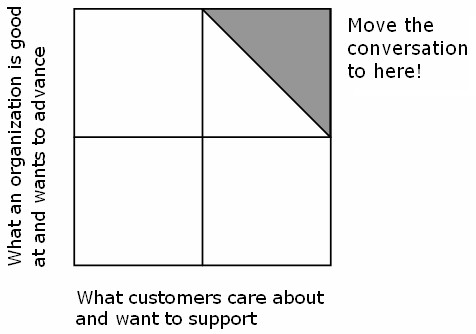For decades, the prevailing wisdom was that nonprofits should learn from for-profit enterprises how to "get their act together" and become "more businesslike." And nonprofits did learn.
Many have embraced best practices in branding, marketing, service delivery, money management, and leadership. They have also learned how to keep different business models running simultaneously: Generating earned income from sales requires different messages, communications, operations, and skills than does garnering philanthropic contributions, whereas generating funds through sponsorships, foundations, or partnerships each presents different challenges and opportunities.
To be successful in all these endeavors has required nonprofits to develop approaches and skills—particularly in communication and branding—that for-profits can learn from.
Connect on a deeper level
A nonprofit's mission and vision give people a reason to participate—and to believe—that's deeper and longer lasting than any specific offering. The value proposition goes beyond fulfilling a tangible or tactical need ("I need A to do B") to fulfill an emotional need. And that connection, when nurtured and sustained, engenders loyalty, creates advocates and ambassadors, and builds relationships that transcend transactions. Customers, participants, board members, and donors feel they are part of a shared enterprise.
For a business, forging this sort of deeper connection can provide market differentiation, create a corps of enthusiastic advocates, and help distance offerings from (dreaded) commodities. (Price is less of an issue if you really believe in a company and what it's selling.)
There are different ways to build this connection: Customers can identify with your mission, they might want to be aligned with what your brand means, or they might seek to be included in your culture—or a combination of the above. Apple, Starbucks, Volvo, and Ikea have benefited by creating such alignments. Forty years ago, Tom's of Maine introduced toothpaste that had meaning far beyond its utility, and user believers became a huge unpaid sales force.
Focus on relationships, not transactions
The Boston Symphony Orchestra (including Boston Pops and Tanglewood) sells more than 600,000 tickets annually. But because the organization is focused on building relationships, there are fewer transactions, and the cost of sales stays low. All communications do their tactical jobs and move people closer to the organization; even modest donors are encouraged to see themselves as investors and partners.
For businesses, a relationship focus encourages repeat customers, lowers the cost of doing business, increases margins, facilitates cross-selling, and gives people a reason to act in your favor that isn't based on price.
Provide "valuable" points of connection
Successful nonprofits know their constituents; they have to. Because people don't have to go to a museum or be a member of a conservation group, it's been imperative that nonprofits understand the rational and emotional drivers of their various constituents—and connect to what those people value. Quantitative and qualitative research is important, but direct interaction and listening are key.
With research and experience in hand, nonprofits—universities, medical centers, or conservation organizations—are adept at crafting different "ways in" for their constituents.
For example, at Boston's Brigham and Women's Hospital, some people care deeply about research around particular diseases, others care about advancing patient care, whereas others care about the training of the next generation of physicians. In addition to an overall message, the organization has crafted individual messages that target what each group is passionate about.
If a business understands the different ways it is valued, it too can develop targeted, values-based messages and themes to move the conversation to the intersection of what it does well and wants to advance, and what constituents care about and are willing to buy or invest in.

Successful nonprofits also acknowledge the "distance" between people and their organizations and engage them appropriately. Public-service media (TV, radio, Web) organization WGBH, also in Boston, recognizes that a longtime member/donor needs to be engaged in a different conversation than does a prospect for membership.
For businesses, acknowledging (on your website, for instance) that prospects need different information and interactions than do repeat customers—and that each group needs to be treated differently and have a different online experience—is important if both groups are to feel well cared for.
Build community
Long before social media provided new tools with which to build shared meaning and community, successful nonprofits were doing just that. Preconcert talks, lab tours with researchers, dinners for 10, nature walks with sanctuary directors, galas, even the opportunity to catch up with an old friend—or make a new one—during an intermission all create shared experiences and connections that advance an organization—immediately and into the future.
One corporate leader who understands this is Apple cofounder Steve Jobs. While businesses have always convened their salespeople, Jobs, at MacWorld, convened "fans."
Leverage every communication opportunity
The nonprofit segment is very efficient because it has been forced to do more with fewer resources. Neither nonprofits nor businesses can afford to have the look and messages of their Web sites differ from those of their printed materials.
For example, at Dana Hall School in Wellesley, Mass., focused approaches to language, imagery, color, and design connect its many endeavors and communications into a portfolio: Print connects to Web, and recruiting communications support those fostering development.
And both for nonprofits and for businesses, leveraging unpaid communication channels—social media, the pride felt by ambassador-advocates, media coverage—extends the reach of every communication dollar.
* * *
Nonprofits have learned a lot from the corporate world; now they have much to teach. One can foresee an eventual convergence, where best practices in branding and communication will be quite similar in both the nonprofit and the for-profit realms.




